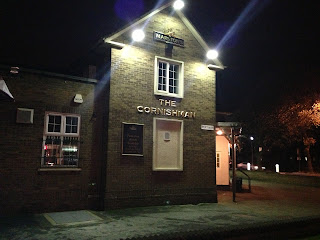
“How do you actually get to Wythenshawe?” was the question I asked myself when it was decided we’d be ticking the delights of Manchester Airport’s neighbouring town. A friend had been to Wythenshawe a few weeks previous to us so we decided to follow his lead and train it over to Heald Green and walk from there. We didn’t see any pubs in Heald Green that were worth bothering with, the only one near the station is a giant Beefeater monstrosity – the type that reminds me of modern identikit football grounds – utterly soulless and frequented by people I really don’t want to mix with.
After asking a couple of people for directions to the nearest pub, we walked for about 20 minutes and eventually found The Tudor.
It’s a good sized pub in the middle of an estate, reasonably priced and a warm welcome to be had from the landlady. It had the selection of lagers, ciders and ales that you'd expect to find in your average estate pub. As I was still suffering from the previous night’s shenanigans (Sinclairs, Football Museum and Knott Bar) I opted for a bottle of cider, poured over ice. Try not to judge me.
The Silver Birch was next and about a 15 minute stroll into the town centre (of which there isn’t much of).
Silver Birch, Poundswick Lane, Wythenshawe. (c) onedayinwatford.
The first I heard about this pub was back in February when some nugget decided to fire a couple of shots at the windows, I think that was what planted the seed to see what these parts had to offer. It’s a pretty big Holt's house that was built in the late 1940’s and was packed when we got in. After a decent wait at the bar we were served and retreated to the only spare table available (we’d done a lot of walking, not a chance of me standing at the bar).
A short walk from the Silver Birch is the Happy Man, a fantastic looking pub and another that was nicely busy when we arrived, although on opening the first door we were met head on by a kids party that was in full swing. Thankfully we were able to swerve that and went in the main bar area. A sign above the bar told us that ‘POLICE SURVEILLANCE CAMERAS ARE OPERATING IN THIS PUB’. Nice.
Just up the road is the Mountain Ash, which was surprisingly quiet when we arrived. It’s another big pub with the bar in the centre of the pub, plenty of nooks and crannies, and (again) CCTV in abundance. Part of the pub was in near darkness until the landlady turned the lights on for us. I’ve read a few bad reviews of this place recently but I have to say that, even though it wasn’t busy, I thought it was a decent pub.
Another 15 minute walk takes us to The Portway, yet another huge pub that was fairly busy when we arrived. We entered through the side door into a room with a small bar and pool table in but because of the clientele in there (lads sprawled out over the seats, dying) we went in the lounge next door.
Next up,
The Cornishman (after a standard circa 10 minute walk). They had the United game on so the place was packed. My
fellow pub ticker hit the jackpot in here when he ordered two beers and was told “that’s three pounds please”, “I asked for two pints” he replied, “that is for two pints love”. They run a live football promotion where it’s £1.50 a pint until the first goal is scored, you can’t grumble at that.

Just down the road is the Red Beret (another big Wythenshawe pub, shock horror!). I tried opening one door but it was locked, thankfully the lounge was open. I ordered the beers and asked the landlady why the other room wasn’t open, she replied simply “MEETING”. I didn’t pursue the conversation. As darkness had long since fallen our thoughts had turned to getting back to Bury, we asked the landlady the distance to the nearest station and she told us Manchester Airport was easily walkable. I double checked the route on the map on my phone and we eventually decided to get gone, in doing so we stumbled upon another boozer - The Woodpecker.
A smaller than your standard Wythenshawe pub, but still a fair size. We had a quick one and then asked a local for a taxi number, only to be told that taxis no longer pick up from this pub. PARDON?! We’d already walked a good 5 miles so an extra mile wouldn’t kill us (and thankfully neither did the locals).
Wythenshawe is well worth an afternoon out, as you’ll have noticed you will walk miles but you’ll visit some of
Manchester’s finest estate pubs [there are many more than the eight visited here].
As a side note, I reviewed the
Spanking Roger for this fine blog earlier in the year. It sadly burnt down a few weeks ago, thankfully no one was hurt. That pub will forever be in my heart, RIP.
Spanking Roger, Sawley Street, Miles Platting, November 2012.


















































